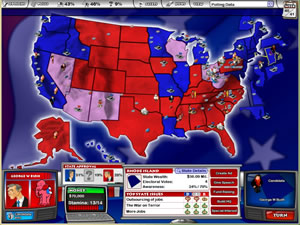Mock the vote.
A few weeks ago I reviewed Doom 3, a dark thrill-ride of horror, gore and terror. What could possibly compete with that? Unfortunately, I didn’t have to look any farther than U.S. politics. If there was ever a creepshow of deceit, monsters, and brain-eating zombies, it’s the upcoming presidential election.
Tricky as it sounds, I’m leaving my own political views
out of this review. I don’t
care whether you think Kerry
is a liar or Bush
is a moron. However, what I might do, and what The
Political Machine definitely does, is put the entire political process
on trial. And that’s the best thing that this game does, because
other than its piercing, accurate, and cynical view of politics, The
Political Machine offers little in the way of fun.
Have
you ever wanted to be a presidential candidate? Me neither. President maybe,
or dictator, but I can’t even imagine going through the unpleasant process of
actually running for office. Oddly enough, this is exactly what The
Political Machine puts you through. It’s the opposite of the god game
– the desperate-process-to-become-a-god game.
You put yourself in the role of the presidential hopeful, flying around the country, making insincere speeches, producing slanderous ads, begging for money, and kissing babies — all in the name of getting votes. You can do all this as either one of our many real life political figures, a few vaguely disguised ones, or you can create your own from scratch. Ubisoft’s lawyers must have been very busy figuring out who was fair game for inclusion and who might be able to sue. Just about anyone who has actually held political office apparently loses all their rights, while political organizations like the NOW or the NAACP are (somewhat) protected with slightly altered names. Let me put it this way: there is a cartoon
version of Arnold Schwarzenegger in this game, yet the governor of California doesn’t get paid a dime. So much for merchandising.
Every candidate is rated on about a dozen attributes, from charisma and religion (Christianity) to military experience and integrity. These will all work themselves out by influencing the voting public one way or another.
Some of the pre-set scores for real life candidates are questionable, though. Whoever assigned George W. Bush’s “media bias” score of 1 must never have seen Fox News, and John Kerry’s “comeliness” score of 6 belies his long face. Fortunately, I was able to create the super-intelligent and rational Sal Magicpants to lead our country to the great future it deserves.
The entire game is played out on a map of the United States, helpfully color-coded. Most of the time you’ll probably find the red/blue map the most handy to see how the populations of each state are leaning. You can’t have a complete political strategy without making sure you have enough electoral votes, however, or visiting the gold colored states for more successful fundraisers.
On top of these United States are tiny icons representing you, your opponent, your running mates, political ad campaigns, and your various hired guns. Each turn represents one week in the 42 weeks leading up to the November elections, and it’s your job to hit the campaign trail. Based on your candidate’s stamina, you’ll be able to perform a limited number of actions for the week: fly to a new state, build a campaign HQ, give a speech, create an ad campaign, hold a fundraiser, or just trade in stamina for political clout.
 States love to have presidential hopefuls visit, so even just showing up in Idaho makes the potato farmers a little grateful. Speeches on hot-button issues can gain you points in a particular state and increase national awareness about the topic. In Michigan, they might be concerned about jobs, while the New York public wants to be reassured about terrorism.
States love to have presidential hopefuls visit, so even just showing up in Idaho makes the potato farmers a little grateful. Speeches on hot-button issues can gain you points in a particular state and increase national awareness about the topic. In Michigan, they might be concerned about jobs, while the New York public wants to be reassured about terrorism.
Political ads can be expensive, having both an initial production cost and ongoing fees to run them, but they are very effective. You can talk up your own abilities or slander your opponent in the papers, on the radio or TV. Much like the current election, almost anything goes – I ran several ads claiming my adversary was against public schools.
Occasionally, political opportunities pop up on the map, which can be good or bad. A Hollywood star might take a shine to your campaign and help you out, a retired general might increase your military credibility, or a tedious old man might steal all your stamina. TV opportunities also appear and you may be asked for an interview on “The O’Maley Scenario” or “Hard Hitter.” Answer a few topical questions in under a minute, and keep your fingers crossed.
Finally, your political clout can be used to bring some of the sleazier (but absolutely necessary) people into your campaign. From the Spin Doctor and the Fixer to the Consultant and the Storyteller, these unscrupulous people are the grease that make political wheels turn.
My strategy was to run Sal Magicpants as a Democrat on a very centrist platform with slightly left leanings when pressed. I figured I’d simply try to offend the least number of people — Sal Magicpants Is For Jobs, Sal Magicpants Is Against Crime, Sal Magicpants Is For The Environment! Who exactly is for crime? My opponent, that’s who!
Although a bit boring, my gambit worked pretty well, and Sal soundly defeated Condoleezza Rice. I had a tougher time against Schwarzenegger, whose star power nearly charmed Florida. But Sal won, and with computerized voting (and voters), there’s never a recount.
There are four different ways to stare at the same map. Quick Game throws you into a single election, while Campaign Mode is really a linear campaign pitting you against 10 different opponents in 10 presidential campaigns and allowing you to unlock secret candidates. I thought you could only serve two terms? Multiplayer mode works fine for lining up one-on-one matches and incorporates all the elements of Fantasy Mode, which you can use to scramble the wealth and political leanings of all the States of the Union, as well as the economy and geopolitical climate.
 The graphics, unfortunately, are as boring as your 8th grade Politics class and look exactly the same. All you do for 42 turns is stare at the map with only a few little icons to distract you. Blech. A few of the The
The graphics, unfortunately, are as boring as your 8th grade Politics class and look exactly the same. All you do for 42 turns is stare at the map with only a few little icons to distract you. Blech. A few of the The
Political Machine‘s diversions involve famous caricatures, but they don’t animate or anything, and a couple of them don’t even look much like the people they represent. Nothing to see here, folks. Move along…
…to the sound, which isn’t gonna win my vote, either. The music is pretty bad
and seems to be on a 20 second loop; I quickly located the option to turn it
off, which left only the sound effects. There’s a little whoosh noise when you
fly to a new state, and a happy people noise when you give a speech. That’s about
it. Some celebrity impersonators doing voices could have made The
Political Machine more fun.
The Political Machine feels a bit like a quasi-educational game
designed to teach you about the electoral process and how many Electoral College
votes you need to be the next resident of the oval office (270). If there’s one
thing I hate, it’s being tricked into learning something.
And while I admire The Political Machine‘s cynical (and accurate) take on politics, it’s just not very much fun to play. By week 30, you’re sick of the whole thing and you wish that people would just get up and vote already. Which, come to think of it, is pretty much how I feel about Bush vs. Kerry.
It might only be $20, but The Political Machine still feels
pretty thin, even for a budget game. It’s more of a novelty, a
third-party candidate – you’ll
like some of what it has to offer, but it’s
still pretty much just wasting your vote.







